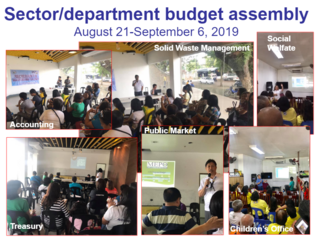2023 Award "Best Practice in Citizen Participation"
17th Edition
Naga City: People’s Budget Ordinance and Voluntary Local Review of Sustainable Development Goals (SDGs)
The People’s Budget Ordinance of Naga City, in the Philippines, is an innovative program that further strengthens the city’s participatory governance by ensuring that local plans and budgets are responsive to the needs of its citizens; are prepared and approved through a transparent and participatory process; and are monitored participatively.
Consequently, it drove the city government to pioneer a Voluntary Local Review (VLR) of Sustainable Development Goals (SDG) in Naga, which the policy mandated to be part of an enhanced planning and budgeting process.
A two-tier public consultation on departmental and city plans and budgets and the pioneering 2022 VLR lie at the heart of this innovation.
Background:
Enacted on October 10, 2017, City Ordinance No. 2017-072 covers both city and barangay budgets. In her explanatory note, former City Councilor Mila Raquid-Arroyo said that a good budget should not only fund public purposes but “should also be truly responsive to the needs of the people.”
Indeed, Naga City has been known for participatory governance. In 1997, it established the Naga City People’s Council (NCPC), the federation of civil society organizations that selects its representatives to all local special bodies and standing committees of the city government. Consequently, its planning documents were crafted with strong people's participation.
But ensuring that these plans are translated into budgets truly responsive to people’s needs remained a huge policy gap for two decades. This is what the program sought to address.
The foray into the VLR is a logical outcome of the policy. In 2020, it took on UNESCAP’s offer for Naga to pilot a voluntary local review of the SDGs in the Philippines. A VLR is a process through which local governments voluntarily undertake a review of their progress on the 2030 SDGs.
Program Objectives:
The program objectives were laid down in the ordinance itself. These are:
1. Results-oriented. “Public funds shall be allocated only for public purpose which must be clearly defined.”
2. Evidence-based. “The annual budget shall be responsive to the situation of the community as reflected in the Community-Based Monitoring System (CBMS) or other local data.”
3. Participative budgeting. “Constituents are given the opportunity to comment on the budget and these are considered by the approving authority prior to approval.”
4. Plan-budget link. “The annual Budget is the lifeblood of the local development plan and the annual investment program formulated in consultation with local constituents.”
Program Strategies:
To achieve them, the program pursued the following strategies:
1. Voluntary local review. Naga pioneered a voluntary review of the SDGs. As a result, it has adopted the VLR as a monitoring tool for its new 2022-30 Comprehensive Development Plan.
2. Regular CBMS surveys. Since 2011, Naga has already implemented three CBMS surveys. They are being used by city government agencies in formulating their plans and budgets.
3. Two-tier public consultations. The NCPC organized a two-tier public consultation process, providing a platform where the public provides feedback on what city agencies are planning to carry out in the next fiscal year.
4. City statistics committee. The city government organized the Naga City Statistics Committee (NCSC) to become the institutional home of the VLR process, as well as the critical monitoring of its plan and budget outcomes.

More information:
- https://www2.naga.gov.ph/
- The Voluntary Local Review of the SDGs in Naga City, Philippines
- Powerpoint presentation - The Naga City People’s Council and the People’s Budget
Report inappropriate content
Is this content inappropriate?





1 comment
Loading comments ...
Loading comments ...